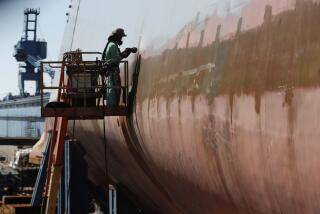Navy Action in Ship Deal Under Review : Defense: House panel will investigate the release of Morrison Knudsen from a price guarantee on delivery of vessels.
- Share via
The House Government Operations Committee said Tuesday that it will investigate the Navy’s decision to excuse Morrison Knudsen from a price guarantee on the AOE-6 ship program--an action that could cost taxpayers $600 million.
Rep. John Conyers Jr. (D-Mich.), committee chairman, said in a letter to Acting Navy Secretary Sean O’Keefe that the release of Morrison Knudsen has already cost taxpayers $100 million and could cost another $500 million. The Times reported details of the case last month.
The AOE-6, a supply ship that would carry fuel, ammunition and food, is a year and a half behind schedule. It is under construction at the National Steel & Shipbuilding Co. yard in San Diego, which until recently was owned by Morrison Knudsen.
Morrison Knudsen wanted to escape the guarantee that it would build four AOE-6 ships for $863 million so that it could sell the shipyard to its employees. Against the advice of Pentagon auditors, who warned that the AOE-6 program was headed for massive cost overruns, the Navy agreed to release the parent firm from the price guarantee on April 12, 1989.
The next day, the shipyard was sold to its employees. Just as auditors had predicted, overruns on the AOE-6 program quickly mounted, prompting Nassco to threaten bankruptcy unless the Navy covered its overruns. Earlier this year, the Navy agreed to pay $237 million to cover some of the overruns.
The Navy had engaged in poor contracting practices that resulted in substantial costs to taxpayers, a defense inspector general’s audit found in April.
Navy officials have refused to discuss the Morrison Knudsen release. A Navy spokesman said Tuesday: “Obviously, if Mr. Conyers is asking for information on the AOE-6 program, he will get it.”
Nassco officials could not be reached for comment. Previously, they said the cost overruns were the Navy’s fault and that the payments made by the Navy were the minimum the shipyard was willing to accept.
As part of the Morrison Knudsen release, the Navy also paid the shipyard $47 million to cover overruns on 10 ship-repair contracts going back to 1985.
The payment is believed to have triggered an acrimonious internal dispute within the Navy, leading to the departure of six civilian contracting officials at the supervisor of shipbuilding office in San Diego, according to government officials who know about the case.
The dispute centered on how much the claims were really worth. The local contracting officials said the Nassco claims were worth no more than $34 million and Defense Department auditors concurred, according to a Navy document called the pre-negotiation business clearance memorandum.
But senior Navy officials rejected the figure as too low, after Nassco said it could not survive without at least $45 million. A letter dated March 17, 1989, from shipyard President Richard M. Vortmann to then-Capt. Eugene Harshbarger asserted: “If the Navy cannot clearly see a settlement in excess of $45 million, then Nassco’s viability is definitely marginal at best.”
New negotiation documents were drafted to increase the Nassco payments after the dispute in April. The new documents also separated the claims on the 10 ships, which under Navy procurement rules allowed them to be paid without the signatures of senior Bush Administration appointees.
The $47-million final settlement was justified by substantially inflating the values of individual claims, the documents show.
In one case, the A-AH19/20 hospital ship, local Navy officials estimated that the claims were worth no more than $1.2 million. But by June, 1989, officials at the Navy Sea System Command in Washington determined $3 million would be paid.
In another case, local Navy officials said claims made for repairs to the destroyer Elliot were worth $11.8 million, but officials in Washington later agreed to pay $17 million.
More to Read
Sign up for Essential California
The most important California stories and recommendations in your inbox every morning.
You may occasionally receive promotional content from the Los Angeles Times.












